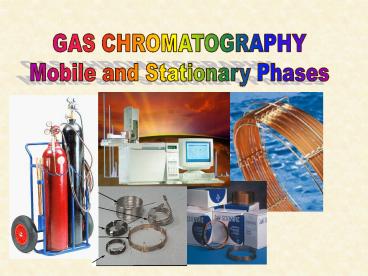GAS CHROMATOGRAPHY - PowerPoint PPT Presentation
1 / 19
Title:
GAS CHROMATOGRAPHY
Description:
The geometry of capillary columns is fairly simple, consisting of length, internal diameter, and stationary phase thickness. Nevertheless, there are endless possible ... – PowerPoint PPT presentation
Number of Views:274
Avg rating:3.0/5.0
Title: GAS CHROMATOGRAPHY
1
GAS CHROMATOGRAPHY Mobile and Stationary Phases
2
Capillary Columns
The geometry of capillary columns is fairly
simple, consisting of length, internal diameter,
and stationary phase thickness. Nevertheless,
there are endless possible combinations of these
three factors that could be used for optimizing
chromatography.
3
Column Length
Doubling the column length effectively doubles
the number of theoretical plates but the
resolution between any two compounds is
proportional to the square root of the plate
number so doubling the column length only
increases resolution by about 40
4
Column Diameter
Smaller Diameter Faster Chromatography Higher
Number of Theoretical Plates Lower Sample
Capacity Higher Detection Limit (lower mass
injected)
5
Column Diameter
6
Film Thickness
Thinner Films Higher N Used for High BP
Compounds Low Sample Capacity Thicker
Films Used for Low BP compounds Less Peak
Tailing for Polar Compounds
7
Film Thickness
8
Stationary Phases
9
Mobile Phase
Lighter gasses are best for fast analysis
(hydrogen) Fast analysis produces narrow peaks
with better detectibility Heavier gasses have
slightly higher N (but only at low
velocity) (not used too much)
10
Mobile Phase
Effect of Mobile Phase Gas Type and Velocity
11
Mobile Phase
There is a drop in pressure as the gas moves
through the column. This drop is pressure
causes the gas to expand which can result in
peak broadening. It also causes the gas
velocity to increase as it moves through the
column
pi/po is the ratio of the inlet velocity(pi) to
the outlet velocity (po).
12
Mobile Phase
As the column oven is heated, the viscosity of
the mobile phase increases. Therefore as the
column is heated during the temperature ramp, the
flow rate goes down. In order to keep a constant
flow ( and reduce peak spreading of later eluting
peaks) a process of pressure programming is used.
The constant flow mode increases the pressure at
the head end of the column, and keeps the mobile
phase velocity constant. Pressure programming
can also be used to increase mobile phase
velocity as the temperature increases, further
decreasing analysis time and increasing peak
height.
13
Kovats Retention Index
The retention time of an analyte provides some
information on the chemistry of the compound.
However, retention time is dependant on many
operational factors such as temperature, column
length, column diameter, coating thickness, etc.
The use of a relative retention value compensates
for many of these variations. The Kovats
retention index is used to calculate relative
retention values based on a scale defined by the
elution of a series of n-alkanes. An index
value calculated for an analytes should be the
same for any chromatographic run as long as the
same stationary phase is used. Information on
the Kovats Index for many compounds can be found
in the literature.
14
Kovats Retention Index
where X refers to the adjusted retention volumes
or times, z is the numberof carbon atoms of the
n-alkane eluting before and (z 1) is the
numberof carbon atoms of the n-alkene eluting
after the peak of interest
15
Kovats Retention Index
The classical Kováts retention index is measured
under isothermal conditions. However, in the
case of temperature-programmed gas chromatography
a similar value can be calculated utilizing
direct numbers instead of their logarithm. In
other words, an equation for the Kovats index can
be developed for a polynomial regression of a
series of alkanes vs. their retention times.
16
Kovats Retention Index
The output from the GC is a series of
peaks. While the output does not tell you what
the peaks, the retention time is useful
information.
Detector Response
Minutes
17
Kovats Retention Index
18
(No Transcript)
19
(No Transcript)

















![Lecture note : Gas chromatography [1] ????????? PowerPoint PPT Presentation](https://s3.amazonaws.com/images.powershow.com/6692254.th0.jpg?_=20150604093)













